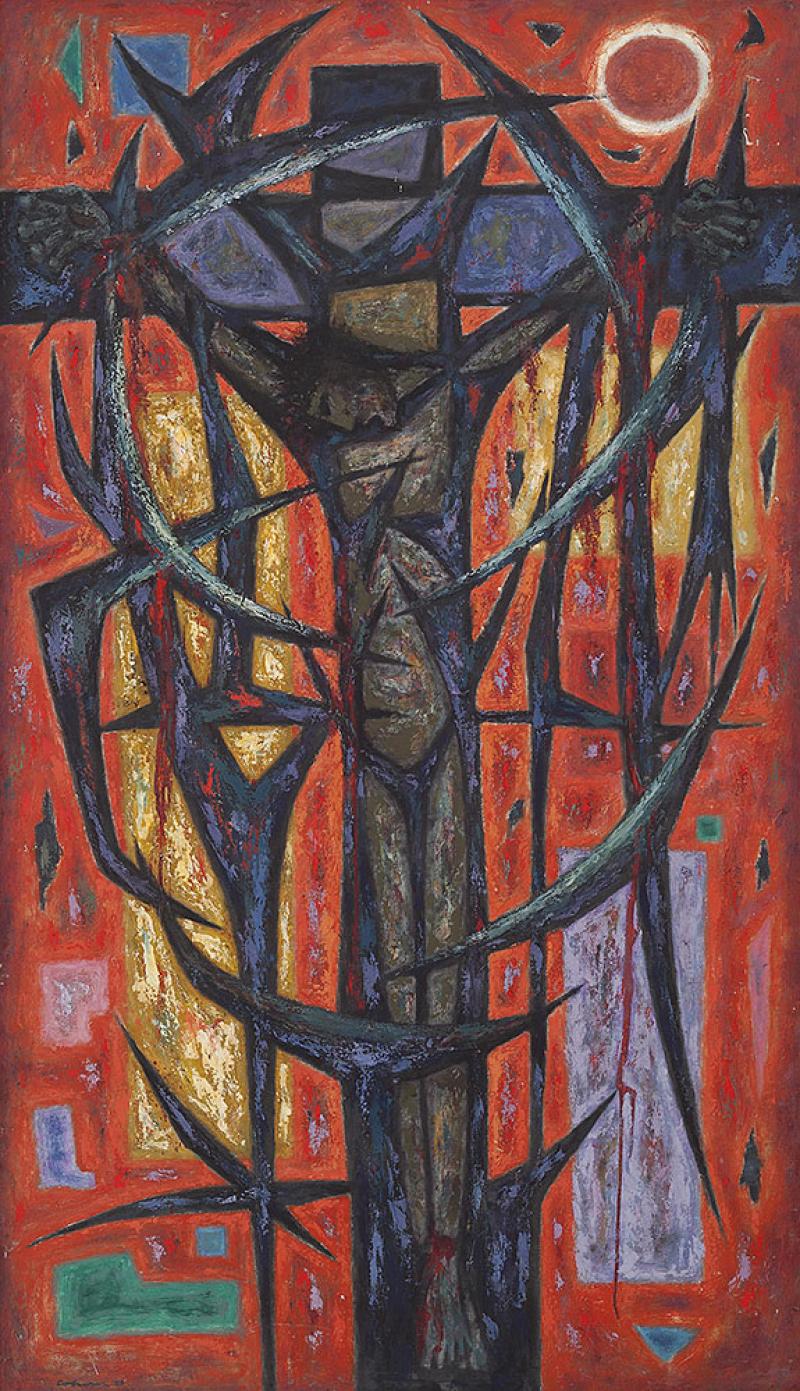JOHN COBURN (1925-2006)
Crucifixion 1959
Estimate: $60000 - 80000
Description
JOHN COBURN (1925-2006)
Crucifixion 1959
oil on board
213.5 x 122.0 cm
signed and dated lower left: Coburn '59
signed, dated and inscribed verso: JOHN COBURN/ 11/688 OLD SOUTH HD RD/ ROSE BAY N.S.W/ "CRUCIFIXION" JAN.'59/ 200 GNS
Provenance:
Acquired from the artist, private collection, Sydney, 1962
Exhibited:
(entered) Blake Prize, Sydney, 1959, no.129 (label attached verso)
Reference:
Rozen, A., The Art of John Coburn, Ure Smith, Sydney, 1979, p.40, pl.6 (illus.)
Amadio, N., John Coburn: Paintings, Craftsman House, Sydney, 1988, pp.34-35, 195 (illus. p.35)
Estimate: $60000 - 80000
John Coburn was one of Australia’s foremost painters of religious or spiritual themes; and Crucifixion marks the point at which the artist embarked on his journey with this theme. Coburn’s paintings are a celebration of creation and he uses his unique iconography to depict the cycle of life.
In 1958, the artist began studying the theme of the crucifixion, experimenting with thorn-like shapes to suggest the suffering of Christ, rather than the physical form of Christ on the cross. Coburn wanted to create a powerful emotional state, rather than a representation of the event. The large, striking Crucifixion, painted the following year, is a triumphant result. Coburn’s suggestion of a Christ-figure from thorns is a rare use of figuration by the artist.
I vividly remember painting Crucifixion. It was large and I painted it in our small flat in the living room. There was hardly room to turn it. I had to make sure the blood ran in the right direction. I felt I needed a figure. We were pioneering abstractions then but I would still put a figure in it.1
In the same year, Coburn painted They Gave Him Vinegar Mixed with Gall, another exploration into biblical themes. Both these dramatic works were influenced by the English artist Graham Sutherland, whose work Coburn had long admired. The artist had visited St Matthews Church in Northampton and was struck by the famous Sutherland Crucifixion. Coburn had thought at the time that it was one of the most successful paintings he had seen on the subject and was most likely influenced by Sutherland’s use of thorn-like shapes.
The culmination of these two thorny Crucifixions was his painting of the following year, The Passion, which won him the coveted Blake Prize in 1960. It was an exciting and meaningful event for the artist, whose Catholicism was very much part of his artistic identity. It was also an important milestone in the artist’s life as the critical acclaim helped to establish him as a career artist. Coburn was to win the Blake Prize again in 1977 with his work, Hozanna.
The absolute core of all Coburn’s work is the concept of renewal. As his prime themes are concerned with nature and religion, so his philosophy and the impetus behind his art is the belief in the regeneration of nature and the resurrection of the human spirit.2
The spiritual paintings produced by Coburn early on in his career were to become significant events on his artistic journey. The acclaim which these works brought him gave the young artist confidence to express his faith through the artistic medium of painting. The artist’s emotional expression is palpable in his work and his abstraction is a vehicle for his quiet passion and humanity.
John Coburn’s work is represented in all major public and private institutions, in addition to major local and international private collections.
Footnotes
1. John Coburn, cited in Amadio, N., John Coburn Paintings, Craftsman House, Sydney, 1988, p.34
2. Amadio, N., John Coburn Paintings, Craftsman House, Sydney, 1988, p.5
Caroline Jones MA (Art Admin.)
Location
SYDNEY VIEWING. 17 - 20 October 11am - 6pm. 12 Todman Avenue, Kensington
MELBOURNE VIEWING. 24 - 30 October 11am - 6pm. Stonnington Mansion, 336 Glenferrie Rd, Malvern
